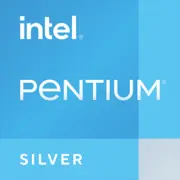Intel Pentium Silver N6005

Intel Pentium Silver N6005: A Budget Processor for Everyday Tasks
April 2025
Introduction
The Intel Pentium Silver N6005 is a processor that has remained popular in budget laptops and compact devices for several years. Despite the release of newer models, it continues to be relevant due to its balance of price, energy efficiency, and sufficient performance for basic tasks. In this article, we will explore who this CPU is suitable for, how it handles tasks in 2025, and what to pay attention to when choosing a device based on it.
Architecture and Process Technology
Jasper Lake: 10 nm and Mobility Optimization
The processor is built on the Jasper Lake architecture (10 nm process technology), which is aimed at low-power devices.
- 4 cores and 4 threads: The lack of Hyper-Threading limits multitasking, but it is adequate for simple scenarios.
- Base frequency of 2.0 GHz: In turbo mode, the cores can boost up to 3.3 GHz, but only for short bursts due to the 10W TDP.
- Integrated graphics: Intel UHD Graphics (Jasper Lake) with 32 EU (Execution Units). It supports 4K@60Hz via HDMI 2.0b and video decoding for formats H.265 and VP9.
Cache memory: 4 MB L3 is modest but sufficient for office applications and browsing.
Key feature — a focus on energy efficiency. Compared to its predecessors (Gemini Lake), the N6005 has improved IPC (instructions per clock) and more stable performance in turbo mode.
Power Consumption and TDP
10W: Quiet Operation and Passive Cooling
The 10W TDP allows the processor to be used in devices without active cooling. This includes:
- Quiet laptops: For example, Acer Swift 1 or Lenovo IdeaPad Slim 3.
- Mini-PCs: Such as the ASUS PN42.
Heat dissipation is minimal: even under load, the laptop's casing does not overheat, which is important for the longevity of components. However, prolonged loads (like video rendering) may result in throttling — a reduction in frequency due to overheating.
Performance in Real Tasks
Office and Multimedia
- Document work: Microsoft Office, Google Workspace — processes run smoothly. Opening 10-15 tabs in Chrome alongside messaging apps is manageable, though with 4GB RAM, there may be some stuttering.
- Video: Streaming 4K (Netflix, YouTube) and H.265 decoding — without issues.
Gaming
The integrated graphics can only handle light projects:
- Minecraft (1080p, low settings): 40-50 FPS.
- CS:GO (720p): 30-35 FPS.
- Indie games (Stardew Valley, Hollow Knight) — perfect.
Turbo mode gives a temporary boost in FPS, but for 3D graphics games, the CPU is on the weaker side.
Use Cases: Who is the N6005 Suitable For?
1. Students: For studying (typing, presentations, Zoom).
2. Office workers: Handling email, Excel, CRM systems.
3. Casual users: Social media, video watching, online shopping.
4. Elderly users: User-friendly interface, long battery life.
Not suitable for:
- Gamers (except for casual games).
- Designers or video engineers.
- Working with "heavy" software (Blender, AutoCAD).
Battery Life: How Long Will the Battery Last?
With a battery capacity of 40-50 Wh, the operating time is:
- 8-10 hours with moderate use (brightness at 50%, Wi-Fi, office tasks).
- 5-6 hours under heavy load (streaming 1080p, multitasking).
Power-saving technologies:
- Intel Speed Shift: Dynamic frequency adjustment to reduce power consumption.
- C-states: Putting cores into "sleep" mode during idle.
Tip: Choose laptops with IPS screens and adaptive backlighting — this can save up to 20% of battery life.
Comparison with Competitors
AMD Athlon Silver 3050e
- 2 cores/4 threads, Vega 3 GPU.
- Pros: Better at handling multithreaded tasks.
- Cons: Higher power consumption (TDP 6W, but actual loads can reach up to 12W).
Apple M1
- Not a competitor due to price (devices with M1 start at $800) but shows how much higher performance can be achieved at the same TDP.
Intel Celeron N5105
- A smaller sibling of the N6005: Lower frequencies (2.0–2.9 GHz), 10-15% weaker in benchmarks.
Conclusion: The N6005 is optimal in its niche (budget up to $500), but it falls behind the Ryzen 3 5300U in multitasking.
Pros and Cons
Strengths:
- Low price of laptops ($300–$450).
- Silent operation.
- Support for modern codecs and 4K.
Weaknesses:
- Weak single-core performance (Geekbench 6: 603 vs 1500 for Core i5-1235U).
- Not suitable for upgrades: often soldered to the board.
- Limited PCIe 3.0 support (only 8 lanes).
Recommendations for Choosing a Laptop
1. Type of device: Ultrabooks (Asus ExpertBook B1), convertibles (Lenovo Flex 3), mini-PCs.
2. RAM: At least 8GB (DDR4-2933).
3. Storage: Must have SSD (256GB or more).
4. Screen: IPS panel, Full HD resolution (not enough power for 4K).
5. Ports: USB-C with Power Delivery support for fast charging.
Examples of models for 2025:
- HP 15s-eq2097ur: 8/256GB, 15.6" IPS, $379.
- Lenovo IdeaPad 3i: 8/512GB, touchscreen, $429.
Final Conclusion
The Intel Pentium Silver N6005 is a processor for those seeking a cheap, reliable laptop without frills. It is ideal for:
- Everyday tasks (browsing, office work, YouTube).
- Users who value battery life (8+ hours).
- The budget segment ($300–$450).
Key benefits: Low price, silent operation, support for 4K. If your needs do not exceed basic scenarios, the N6005 remains a cost-effective choice even in 2025. However, for more demanding tasks, it is worth considering devices with Ryzen 5 or Core i3/i5.
Basic
CPU Specifications
Memory Specifications
GPU Specifications
Miscellaneous
Benchmarks
Compared to Other CPU
Share in social media
Or Link To Us
<a href="https://cputronic.com/en/cpu/intel-pentium-silver-n6005" target="_blank">Intel Pentium Silver N6005</a>